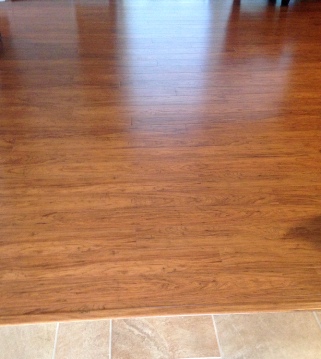Find a Mold Specialist Now
Click or Call, Toll-Free 24/7
Water Damage Laminate Floor
When it comes to water damage, laminate floor coverings often fare better than other types of flooring. As long as you wipe up any spilled water promptly, the floor should be no worse for the wear.
Flooding or other significant water damage is a different story. When laminate flooring is saturated with water, especially for a period of time, damage will occur. Repairing the damage correctly is important then, both to restore your floor to its former attractive appearance and to prevent the development of problems such as mold growth.
Still, laminate floors are increasingly popular among homeowners, as they look nice, are affordable, and are relatively easy to maintain, especially compared to carpet or hardwood floors. With the proper care, laminate floors will last a long time.
We’ll provide some tips for preventing water damage to your floors. We’ll also tell you what to do if your laminate floor suffers water damage, including when and how to get some professional help with the job.
Preventing Water Damage to Floors
You can’t prevent floods, but you can do things to reduce the risk of water damage to your floors from other sources. Wipe up any spills immediately. Keep your plumbing, appliances and roof in good repair. Check periodically for leaks under sinks, behind toilets and around appliances like water heaters and dishwashers. Fix any leaks right away.
Signs of Water Damage Laminate Floor Coverings May Suffer
Water damage to laminate floors is usually pretty obvious and easy to spot. Signs that your laminate floor has suffered water damage include:
- Buckling
- Splitting
- Cracking
- Discoloration
- Visible mold
- A musty odor of mold
Repairing Water Damage Laminate Floor Coverings Have Sustained
Repairing laminate floors can be difficult because it’s often hard to find new laminate that matches the existing flooring exactly. For this reason, homeowners often choose to replace the entire floor instead of repairing just the damaged portion. Consider the expense involved as well as how closely you can match your existing floor when making this call. If the laminate doesn’t match, your floor may look rather odd.
To repair a water-damaged laminate floor, use a crowbar or other tool to pry up the damaged planks. You’ll need to remove one plank at a time. The entire plank must be removed even if only a portion of it appears damaged because each plank is a single unit.
Carefully inspect the floorboards beneath for signs of damage such as warping or mold. If there is any damage, then that damage will need to be repaired before you replace the laminate flooring. Don’t skip this step. Putting laminate flooring down on a damaged subfloor will only lead to problems down the road. If you’re not sure if a section of the subfloor needs to be replaced, consult a professional or just play it safe and replace it.
Allow the floorboards to dry completely (this make take several days) before replacing the laminate flooring. Otherwise, you risk ending up with mold beneath your floor. You can read all about subfloor mold to learn why it is so hazardous. You’ll also find valuable information about repairing damage to subfloors there.
If your home has suffered water damage to other areas beyond your laminate floor, you can read about cleaning up water damage throughout the home.
For Help Repairing Water Damage Laminate Floor Coverings Have Sustained
For help repairing water-damaged laminate flooring, as well as any other water damage to your home, contact an experienced water damage contractor. He or she can advise you about whether or not to replace the entire floor and help you make sure the subfloor beneath your laminate flooring is in good shape.
Note that if your home has been flooded, the U.S. Environmental Protection Agency (EPA) recommends calling in a professional, though some homeowners opt to handle smaller jobs on their own. We suggest consulting a professional even if you are leaning towards doing the work yourself, just so you’ll have all the facts you need to make a fully-informed decision.
In some cases, your homeowner’s insurance may cover some or all of the cost of having the work completed by a professional. Contact your insurance agent with questions about your policy. An experienced water damage contractor can also help you sort that out, as these professionals are accustomed to working with insurance companies.
Follow this link to get a list of qualified professionals in your area.
Return From Water Damage Laminate Floor To Our Main Water Damage Page
Privacy Policy Terms and Conditions Accessibility Do Not Sell My Information Disclaimer Contact Us





